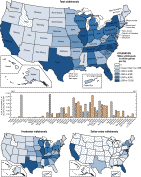
 |
Estimated Use of Water in the United States in 2000
Thermoelectric Power
Water for thermoelectric power is used in generating electricity with steam-driven turbine generators. For 2000, thermoelectric-power water withdrawals were compiled by cooling-system type because cooling-system type is the primary determinant for the amount of consumptive use relative to withdrawals. Once-through cooling refers to cooling systems in which water is withdrawn from a source, circulated through the heat exchangers, and then returned to a surface-water body. Closed-loop cooling refers to cooling systems in which water is withdrawn from a source, circulated through heat exchangers, cooled, and then recycled. Subsequent water withdrawals for a closed-loop system are used to replace water lost to evaporation, blowdown, drift, and leakage. Closed-loop cooling results in larger consumptive-use values relative to withdrawals. Water withdrawals were reported as freshwater or saline water. For 2000, public-supply deliveries to thermoelectric-power plants, water use by fuel type, consumptive use, and the amount of power generated were not reported.
Thermoelectric-power withdrawals are listed by State in table 12.
![]() The total quantity of water withdrawn for thermoelectric power for 2000 was an estimated
195,000 Mgal/d, or 219,000 thousand acre-feet per year. Surface water was the source for
more than 99 percent of total thermoelectric-power withdrawals. Nearly one-third of the
surface water was saline. Saline withdrawals from surface water sources accounted for 96 percent
of the total saline withdrawals for all categories. Thermoelectric-power withdrawals accounted
for 48 percent of total water use, 39 percent of total freshwater withdrawals for all categories,
and 52 percent of fresh surface-water withdrawals. Estimates of freshwater and saline-water
withdrawals were each about 3 percent more for 2000 than for 1995.
The total quantity of water withdrawn for thermoelectric power for 2000 was an estimated
195,000 Mgal/d, or 219,000 thousand acre-feet per year. Surface water was the source for
more than 99 percent of total thermoelectric-power withdrawals. Nearly one-third of the
surface water was saline. Saline withdrawals from surface water sources accounted for 96 percent
of the total saline withdrawals for all categories. Thermoelectric-power withdrawals accounted
for 48 percent of total water use, 39 percent of total freshwater withdrawals for all categories,
and 52 percent of fresh surface-water withdrawals. Estimates of freshwater and saline-water
withdrawals were each about 3 percent more for 2000 than for 1995.
The geographic distribution of total, total freshwater, and total saline-water withdrawals
for thermoelectric power is shown in figure 12.
 The largest total water withdrawals were in
Texas, where both freshwater and saline water were utilized for cooling purposes. Illinois,
Texas, and Tennessee combined accounted for 22 percent of total freshwater withdrawals.
California and Florida accounted for 41 percent of saline surface-water withdrawals. Freshwater
and saline-water withdrawals in the eastern States were 83 percent of total water withdrawals.
This pattern of withdrawals exists partly because the power-production infrastructure was
established in the eastern States to take advantage of the plentiful water supply in the
Great Lakes, along major rivers, and along the coast in order to meet electricity demand
from large urban and industrial centers.
The largest total water withdrawals were in
Texas, where both freshwater and saline water were utilized for cooling purposes. Illinois,
Texas, and Tennessee combined accounted for 22 percent of total freshwater withdrawals.
California and Florida accounted for 41 percent of saline surface-water withdrawals. Freshwater
and saline-water withdrawals in the eastern States were 83 percent of total water withdrawals.
This pattern of withdrawals exists partly because the power-production infrastructure was
established in the eastern States to take advantage of the plentiful water supply in the
Great Lakes, along major rivers, and along the coast in order to meet electricity demand
from large urban and industrial centers.
In contrast, the Pacific Northwest utilizes hydroelectric-power generation to supply a substantial part of the regional demand for electricity. For example, in Idaho, power is supplied primarily by hydroelectric-power generation, and, therefore, Idaho reported no withdrawals for thermoelectric power. Hydroelectric power, an instream use, is not included in this report.
Thermoelectric-power withdrawals are listed by cooling-system type and by State in
table 13.
Power plants equipped with once-through cooling systems accounted for 91 percent of water
withdrawals for thermoelectric power. Plants equipped with closed-loop cooling systems
withdrew the remaining 9 percent of the water. Cooling technologies that require less
water also allow for the production of thermoelectric power in areas where water is
scarce or strictly managed (Michelletti and Burns, 2002). Such water-scarce States as
Arizona, Nevada, and New Mexico utilized closed-loop cooling systems rather than the
![]() more water-intensive once-through cooling systems during 2000. During 2000, about 75
percent of the generating units using closed-loop cooling systems reported rates of
consumptive use greater than 50 percent (U.S. Department of Energy, Energy Information
Administration, 2003a, 2003b).
more water-intensive once-through cooling systems during 2000. During 2000, about 75
percent of the generating units using closed-loop cooling systems reported rates of
consumptive use greater than 50 percent (U.S. Department of Energy, Energy Information
Administration, 2003a, 2003b).
In coastal areas, the use of saline water instead of freshwater expands the overall available water supply. More than 90 percent of the thermoelectric-power withdrawals were saline in Puerto Rico (100 percent), U.S. Virgin Islands (100 percent), Rhode Island, California, Massachusetts, Connecticut, Florida, and Maryland. Saline ground-water use by geothermal power plants in Nevada (78.7 Mgal/d), California (32.9 Mgal/d), and Utah (0.87 Mgal/d) was compiled, but excluded from the total water withdrawals and tables in this report. Thermoelectric-power withdrawals for Hawaii were all ground water for once-through cooling systems (1,200 Mgal/d). Saline ground-water withdrawals supplied 96 percent (1,150 Mgal/d) of the total. Hawaii's thermoelectric-power data were excluded from the total water withdrawals and tables in this report.
Sources of data for thermoelectric-power water use included individual facilities, State permitting or regulatory agencies, or the USDOE-EIA. Generally, relatively complete files on water withdrawals and power generation were maintained by these entities for 2000.
Water Use in the United States | USGS Water Resources of the United States
For more information: wu-info@usgs.gov